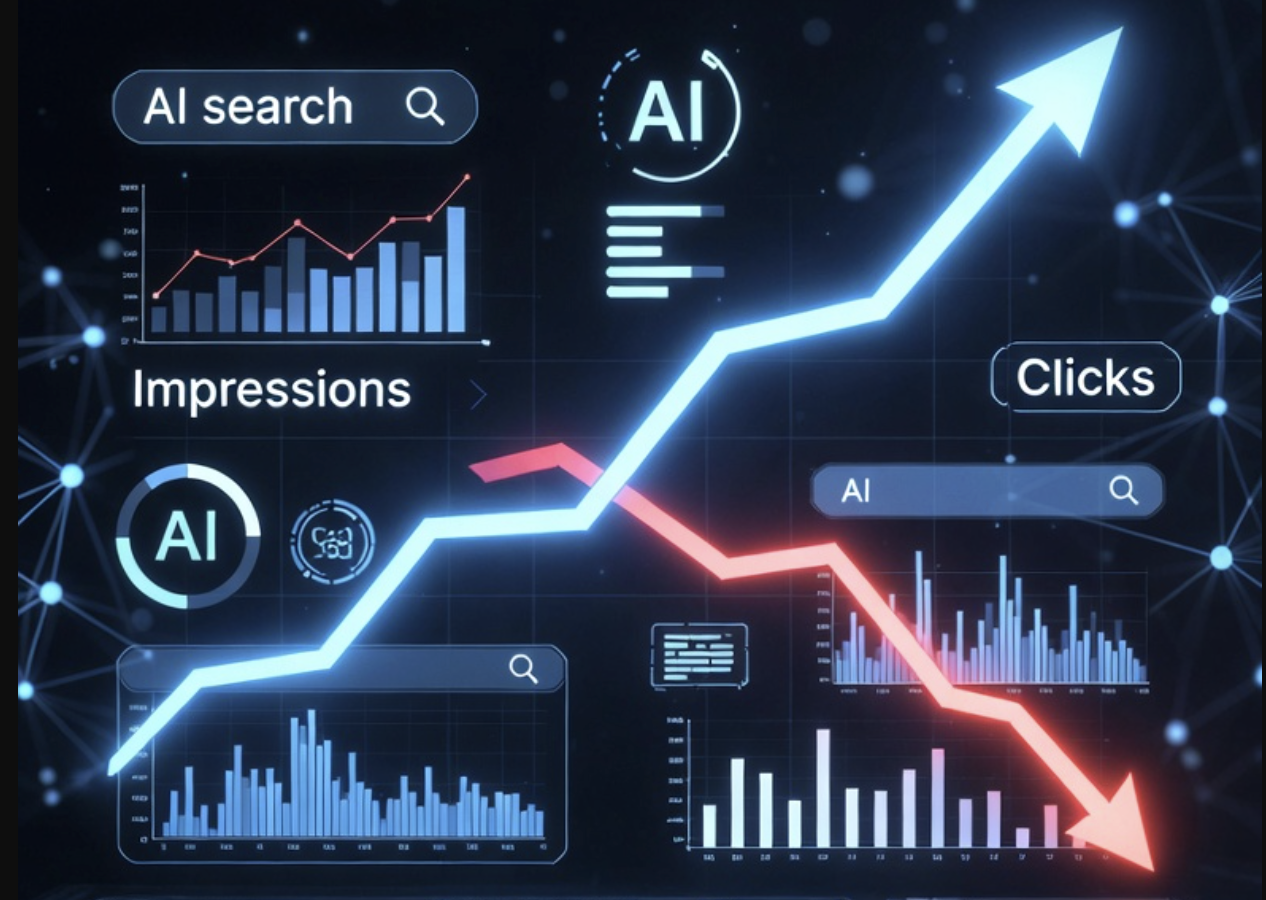The Rise of LLM Traffic: Why Your Impressions Are Up — But Clicks Are Crashing
Reading time: 8 minutes
The Problem Every Business Owner Is Seeing Right Now
You’re checking your analytics dashboard and something doesn’t add up. Your organic impressions are climbing. Your keyword rankings haven’t dropped significantly. Yet somehow, your click-through rates are declining and conversions feel… flat.
Before you blame a Google algorithm update or increased competition, consider this: a fundamental shift in how people search is happening right now, and most businesses aren’t measuring it.
The culprit? Large language model (LLM) search and AI-powered summaries that answer questions before users ever click through to your site.
If you’re not tracking LLM traffic and visibility, you’re missing a critical piece of the puzzle. Here’s what’s happening, why it matters to your bottom line, and what you need to benchmark immediately.
The Data You Need to See
Click-Through Rates Are Plunging Across the Board
The numbers are stark:
- Informational queries with AI Overviews: Organic CTR has dropped 61% since mid-2024
- Queries without AI Overviews: Still seeing a 41% decline in organic CTR
- The takeaway: This isn’t just about AI summaries—clicks are declining everywhere
Zero-Click Searches Are Now the Majority
Current industry data shows approximately 60% of all Google searches now end without a click. Users are getting their answers directly on the search results page, whether through featured snippets, knowledge panels, or AI Overviews.
Think about what that means for your business: more than half of all searches that show your site in results may never send you a visitor.
The Great Decoupling: Impressions Up, Clicks Down
Sites across industries are reporting the same pattern:
- Impressions holding steady or increasing
- Click volume declining month over month
- The gap between visibility and traffic widening
This phenomenon—dubbed “The Great Decoupling”—represents a fundamental change in the search-to-site pathway.
LLM Traffic Is Exploding (While You’re Not Watching)
According to recent research:
- AI search traffic is up 527% year-over-year
- Some forecasts predict LLM-originated traffic may surpass traditional search traffic by 2028
- Conversational AI tools (ChatGPT, Perplexity, Claude) are becoming primary research tools for decision-makers
Here’s the critical insight: This traffic exists whether you’re tracking it or not. The question is whether your brand is visible in these channels.
Understanding the Shift: What’s Actually Happening?
1. AI Overviews Are Intercepting Clicks
Google and other platforms are increasingly answering queries directly on the SERP through AI-generated summaries. When a user’s question gets answered in an “AI Overview” box at the top of results, they often don’t need to click any further.
Your site might be the source of that AI-generated answer, but you won’t see the click in your analytics.
2. Chat-Style Interfaces Are Replacing Keyword Searches
User behavior is evolving rapidly:
- Traditional: User types “best CRM for small business” → clicks through results
- New pattern: User asks ChatGPT or Perplexity “What CRM should I use for a 10-person sales team?” → gets comprehensive answer with maybe 1-2 click-throughs for verification
For business owners and marketers, this means the discovery moment is happening in a different place entirely.
3. The Metrics of Success Are Changing
The old equation was simple:
High Rankings → High Impressions → High Clicks → ConversionsThe new equation is more complex:
High Rankings → High Impressions → AI Summary Appearance → Maybe Clicks (But Definitely Influence) → ConversionsVisibility now matters as much as traffic. Being cited in an AI response builds authority and awareness even without the immediate click.
Why This Matters for Your Business (Not Just Your Traffic Numbers)
Your KPIs Need to Evolve
If you’re still measuring success purely by organic sessions and click-through rates, you’re missing the bigger picture. High impressions with declining clicks doesn’t necessarily mean you’re losing—it might mean you’re winning in channels you’re not tracking.
Audience Behavior Has Fundamentally Changed
Today’s buyers—especially executives and decision-makers—are doing deep research before ever visiting a website. They’re:
- Asking AI assistants for recommendations
- Getting synthesized answers from multiple sources
- Only clicking through when they’re ready to take action
This means: The visitors you do get may be higher quality and further down the funnel than before.
Competitive Advantage Is Being Redefined
Right now, while most businesses are still optimizing exclusively for traditional SEO, there’s a window of opportunity for early movers to:
- Establish authority in LLM-generated responses
- Become the cited source in AI summaries
- Build brand recognition in conversational search contexts
Brands that wait will find themselves invisible in the fastest-growing discovery channel.
Your Traditional Tools Are Blind to This Shift
Google Analytics tracks clicks and sessions. Google Search Console tracks impressions and rankings. But neither tells you:
- How often your content appears in ChatGPT responses
- Whether Perplexity cites your brand
- If AI Overviews are using your content
- What questions LLMs are associating with your brand
Without this visibility, you’re making strategic decisions with incomplete data.
The Quality vs. Quantity Trade-Off May Work in Your Favor
Here’s a counterintuitive finding: Early data suggests that traffic from AI/LLM channels may convert better than traditional organic traffic, even at lower volumes.
Why? Because users who click through from an AI-assisted search have often:
- Done more thorough research
- Received filtered, relevant information
- Self-selected as genuinely interested in your solution
Translation: You might get fewer visitors, but they could be worth more.
Critical Benchmarks to Set Today (Before It’s Too Late)
Don’t wait until the shift is complete. Here’s your action plan:
1. Establish Your Historical Baseline
Action: Export 12-18 months of data from Google Analytics and Search Console
- Impressions by page and query
- Clicks and click-through rates
- Top-performing pages and keywords
- Conversion rates from organic traffic
Why: You need a “before” snapshot to measure the transition’s impact on your business.
2. Identify LLM-Leak Pages
Action: Flag pages where impressions are stable or increasing, but clicks and CTR are declining month-over-month.
Why: These pages are likely appearing in search results but having their traffic intercepted by AI Overviews or being used to answer LLM queries without sending you clicks. They’re prime candidates for optimization.
3. Start Tracking LLM Visibility
Action: Implement systematic tracking of your brand’s appearance in:
- AI Overviews (Google)
- ChatGPT responses
- Perplexity citations
- Claude conversations
- Other AI-assistant tools
Tools: Platforms like AI View can automate this monitoring. Manual spot-checks work for small-scale tracking.
Why: You can’t manage what you don’t measure. LLM visibility is now as important as search rankings.
4. Define New Success Metrics
Action: Establish KPIs for the LLM era:
- Number of AI summary appearances per month
- Brand mentions in LLM responses for target queries
- Citation frequency in AI-assisted search results
- Click-through rate from LLM environments (when trackable)
- Share of voice in AI-generated competitive comparisons
Why: Traditional metrics alone won’t capture your market position in this new landscape.
5. Map Your Content Gaps
Action: Create a spreadsheet identifying:
- Pages ranking well in organic search but absent from AI responses
- High-value queries where competitors appear in LLM results but you don’t
- Topics where you have authority but no LLM visibility
Why: These gaps represent immediate optimization opportunities where you could capture visibility.
6. Track Conversion Efficiency Changes
Action: Monitor not just conversion rate, but conversion rate by traffic source:
- Organic search conversions
- Direct traffic conversions (may include LLM-influenced visitors)
- Referral patterns that might indicate AI-assisted discovery
Why: If conversion rates improve while volume declines, it validates the “quality over quantity” hypothesis for LLM traffic.
Strategic Actions: What to Do Next
Audit Your Content for LLM Readiness
Your content needs to work in two contexts now: traditional search results and LLM knowledge bases.
Make it LLM-friendly:
- Structure content to answer specific questions clearly
- Use schema markup and structured data extensively
- Write in a way that’s easy to extract and summarize
- Include clear, authoritative statements that can be cited
- Add relevant context and definitions
Example: Instead of “Our platform helps teams collaborate,” write “Teams using [Product] reduce project completion time by 30% through real-time collaboration features including shared workspaces, version control, and integrated communication tools.”
The second version is extractable, specific, and citation-worthy.
Implement llm.txt or Similar Guidance Files
Think of this as a sitemap for AI systems. An llm.txt file helps LLMs understand:
- What your site is about
- Your areas of expertise
- How different content sections relate
- Context for interpreting your pages
This is bleeding edge but important: Early adopters will have better representation in LLM knowledge bases.
Optimize for “Visibility Before the Click”
Shift your mindset from “How do I get clicks?” to “How do I get cited?”
Strong citations and appearances in AI-generated responses:
- Build brand authority and recognition
- Create familiarity before the user visits your site
- Position you as a trusted source
- Drive downstream conversions even without immediate clicks
Strategic insight: Being the answer ChatGPT gives to 10,000 queries about your industry may be more valuable than 1,000 clicks from traditional search.
Double Down on Conversion Rate Optimization
If you’re getting fewer but better visitors, your site needs to convert them efficiently.
Focus on:
- Clear value propositions immediately visible
- Streamlined conversion paths
- Trust signals and social proof
- Multiple conversion options (demo, trial, contact, download)
- Exceptional page speed and user experience
Remember: A 5% conversion rate on 1,000 visitors beats a 2% conversion rate on 2,000 visitors.
Competitive Intelligence in the LLM Space
Action items:
- Regularly query LLMs about topics in your industry
- Document which competitors appear in responses
- Analyze what makes their content citation-worthy
- Identify gaps where you could claim authority
Pro tip: Use different LLMs (ChatGPT, Claude, Perplexity) as they may have different source preferences and recency.
Create Content That Serves Both Channels
The best approach isn’t either/or—it’s both.
Dual-optimized content:
- Answers questions clearly for AI extraction
- Provides comprehensive value for human visitors
- Includes both concise summaries and detailed explanations
- Uses structured data for machines and engaging storytelling for humans
The Bottom Line: This Is Happening Now
The shift from traditional search to AI-assisted discovery isn’t coming—it’s here. Your website’s impressions haven’t dropped because people are still searching. Your clicks have declined because they’re getting answers without clicking.
This creates two paths forward:
Path 1: Wait and React
- Keep optimizing for traditional SEO only
- Watch clicks continue declining
- Scramble to catch up when LLM traffic becomes unavoidable
- Lose visibility in the fastest-growing discovery channel
Path 2: Adapt and Lead
- Start tracking LLM visibility today
- Optimize content for both search engines and AI systems
- Build authority in AI-generated responses
- Position your brand where your audience is actually researching
The choice is yours, but the window for early-mover advantage won’t stay open forever.
Your Next Step
The most dangerous position is not knowing where you stand. Before you can optimize for LLM visibility, you need to establish your current baseline.
Here’s what to do this week:
- Export your last 18 months of Search Console and Analytics data
- Identify your top 20 “impression rich, click poor” pages
- Manually test 10 queries in ChatGPT and Perplexity to see if your brand appears
- Document what you find
Or skip the manual work and get comprehensive LLM visibility tracking with AI View. Understand exactly where you appear in AI-generated responses, which queries trigger mentions of your brand, and how you compare to competitors in the LLM space.
Start your free trial of AI View →
The next era of search is already here. The only question is whether you’ll be visible in it.
About AI View: We help businesses track and optimize their visibility in LLM-powered search and AI assistant responses. Get the insights you need to succeed in the evolving search landscape.





